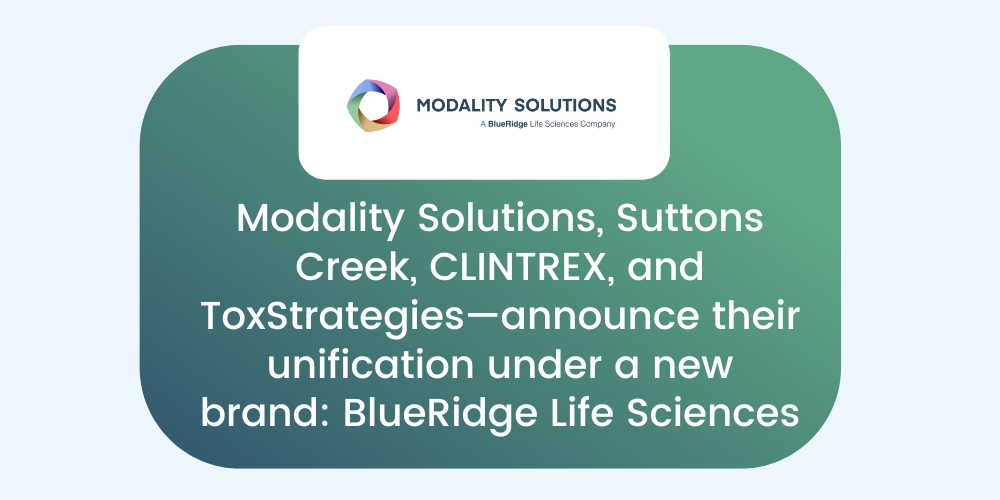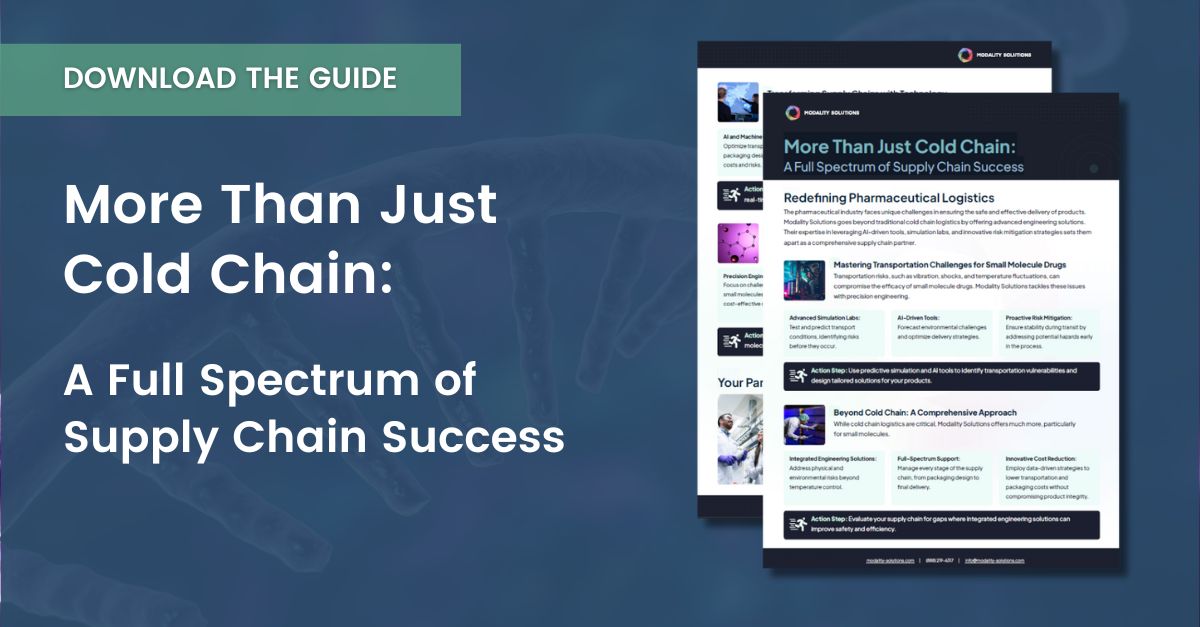Q&A: Regulatory Shifts in the Pharmaceutical Cold Chain
We sat down with Gary Hutchinson, President of Modality Solutions, to gather his perspective on hot topics in the pharma cold chain landscape right now. From fast-track reviews of EUA applications to pitfalls in temperature tracking and validation, to regulatory trends around remote clinical trials—the knowledge of Gary and his team has carved a niche environment for accelerated clinical trials and cold chain support.
Q: What are some trends in EUA strategies that might create hurdles in the industry?
A lot of companies are using emergency use authorization to ignore best practices to accelerate approval of their developing drugs, especially in this aggressive Covid landscape. This is a risky process because they still need to finalize their data package, but sometimes are too driven by their desire to help patients to thoroughly complete the requisite tasks. Usually, there would be an accumulation of vast data during the Phase III trial (which evaluates long-term benefit), but in the EUA fast-track, these safety guidelines are often not being thoroughly addressed (or even completed) before EUA approval. Instead, the companies might pursue small-scale trials. However, they are discovering that these smaller trials aren’t giving the same data set, and the drugs aren’t nearly as effective as thought during the early stages. Plus, they aren’t going back to perform the larger trials because now they have EUA. It’s a significant risk.
Regulatory bodies are becoming vigilant about following up on this data gap. Drug approvals are starting to come a lot earlier in the process with EUA, and companies are making the mistake of stopping the validation work at EUA approval—and this includes cold chain validation. But it’s catching up with these biopharmaceutical companies. It’s still a necessary part of the complete data package. This is a disturbing trend, and the FDA is watching. Prepare your data packages thoroughly, and if you have EUA, make sure you have a complete package, including proper cold chain validation. If not, it might come back to bite you.
Q: How do the regulatory authorities view the recent explosion of temperature tracking technology and devices?
This is a great topic and is reflective of CAR T-cell therapies and the complexities of a supply chain that comes with such a unique, personalized biotherapeutic product. “Real-time tracking” is an innovation but also a loaded gun; the real-time data makes a ton of sense because you must measure temperature and environmental control, but you also need to guarantee chain of custody and chain of control. These new temperature devices are very advanced but come with several risks.
One example is it creates live data immediately, which can be helpful, except that our gut reaction is to react instantly to data that indicates a deviation. You might be inclined to ship replacement product, but then in a more detailed review of your temperature tracking data, the product has no risk to patients. It may have just been a process control of a procedural issue, resulting in reshipment of a very expensive replacement drug when you didn’t need to.
This is why proper validation is critical. These temperature tracking technologies need to be validated—not just relying on a data package from the vendor, but validated for your own shipping and environmental scenarios. This ensures the data is as reliable as possible.
We’re launching our partnership soon with a software company called Parcel Shield which does a lot of visibility, tracking and intervention services for the pharmaceutical industry. Their ability to track and do intervention makes a ton of sense for all clinical trials, but especially CGT (cell & gene therapies). Partnering with companies with these technological capabilities allows a higher level of consistency and management of the temperature side of cold chain. It’s the smart thing to do.
Q: Regarding validation of the temperature tracking technologies, how thorough does pharma need to be, to have a proper data package? Do you think they rely on the manufacturer’s validation package without performing validation in their own environments?
I think companies are getting more comfortable with using the manufacturer’s data package. But you still must do your own assessment and compare it to your requirements. How does that measure up to your specific lanes, your specific use case? These companies must assess and determine why the manufacturer’s data gives you confidence in your cold chain with your product.
We do a ton of that work right now. A lot of times our potential clients don’t understand the risks of relying solely on manufacturer-supplied data. They just say, “We don’t need any thermal packaging validation support because it’s already been pre-qualified.” But pre-qualified to what? To what standard, which supply chain, what thermal temperature or ranges? Assuming the data package from the manufacturer is complete and provides full validation comes with risk, as this is often not the case.
Q: What do the regulatory authorities expect from pharma companies regarding shipping supplies, boxes, equipment, etc.?
All of these are critical aspects of your cold chain management, and of your data package. Period. In the past, cold chain suppliers haven’t been processed through the “approved supplier” bucket and haven’t been managed through supplier audit processes. But cold chain management is a vulnerability, and the biopharma industry needs to manage cold chain just like other major suppliers. Do they have performance metrics that need to be in place? What is the packaging technology? What is the tracking or the temperature monitoring technology, have they done a deep dive on their carrier base? Controls and their predictive and preventive maintenance program? Pharma needs to consider what are they doing from a supplier audit perspective, and needs to conduct ongoing audits over time to manage that risk.
Q: If a pharma company performs their cold chain validation internally, is it a risk for their staff to assume they know they are doing?
Yes, this is a risk. Sometimes companies (and people) don’t know what they don’t know. They think they have all the knowledge—and they might—but it’s a risk to assume this knowledge is current best practice.
Even if a company is performing its own cold chain validation, we can bridge that gap between the engineering team (that understands the materials, qualification and testing) and the quality management group. There should be some oversight or audit regarding the data package from the engineering team. Too many incorrect assumptions can be made: “We’ve performed OQ and PQ, so we have a qualification package,” or, “We have a data package that says that the box should perform as expected.” They may have tested and done triplicate fields, and three field verifications. Then they think their job is done.
But the expectation from a regulatory perspective is once you have a validated system in place, make sure it’s complete and perform an ongoing review of that system. This is to ensure it’s still performing as intended. That’s where companies make a mistake; they assume the packaging manufacturer understands the variances in their manufacturing process, and they don’t perform ongoing review of the system performance. That’s where our expertise can help assess the breadth and depth of the packaging testing qualification package provided by the internal department—evaluating through an assessment, an audit of sorts, and providing guidance along the way.

Q: Do the regulatory authorities review remote trials differently from US-based trials with respect to challenges such as weather, stability of electricity, language differences, etc.?
I don’t think regulatory authorities review it any differently based solely on location, but there definitely are considerations regarding local regulations. One example was a client of ours, a large European-based company with a firm grasp on EU requirements. When they decided to launch their first US-based drug, they needed help navigating US regulations.
Whenever a company is launching a drug in another country, it gets tricky: the local regulations can cause hiccups in clinical trial logistics. You must follow regulations from multiple countries, especially because that data will primarily be used for multi-jurisdictional filings. So, if you’re collecting the data in Europe, but you’re going to use that data for multiple regional filings, you essentially must collect that data and follow all the different regional requirements for where the data will be used.
It doesn’t matter the location—US, Europe, or sub-Saharan Africa—you must follow the regulations for the countries that will receive your data. This is where our team has expertise in global approaches and clinical strategies in a way that aligns with local filings – it’s something that is often missed by many clients.
Q: Do you see a lot of pharma companies understanding how they need to get that done properly?
Many pharma companies completely over-complicate cold chain validation. They think they must develop a thermal profile for every season, origin and destination, ultimately spending hundreds of thousands of dollars in data collection.
But will they know with absolute certainty what the temperature profile is going to be, from a specific point-of-origin to a specific destination? The problem is, no matter how much data you collect, the next shipment is going to be outside of that range. It’s just math. It’s just statistics. You need an engineer’s discipline to approach much of this, and often that’s a gap in our clients’ approach. That’s where we have expertise to plan the proper approach that’s not overkill. We live in this environment. This is what we do. And that’s where we can ensure the client’s cold chain is solid.
—
For global expertise around the cold chain and regulatory expectations, reach out to the Cold Chain Engineers™ at Modality Solutions.




